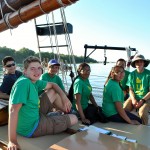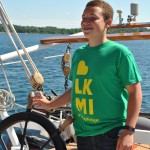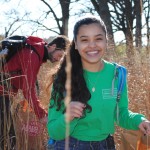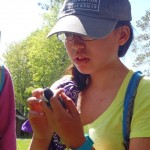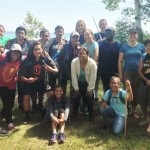



High School Stewardship Program
For High School Students who have completed the Certificate Program
- Gain experience through restoration ecology stewardship work
- Learn about careers in conservation
- Go on a week-long leadership expedition
Restoration Ecology Stewardship Work
The Stewardship Program allows students to use their new-found knowledge as they gain real world experience working alongside professionals in environmental education, land management, habitat restoration, wildlife management and organic gardening.
Students participate in restoration ecology work for 5 weeks—plus a one-week Leadership Expedition—beginning in late June and continuing until late July. Interns work alongside Lake Forest Open Lands Association staff and summer employees.
Students take an exciting Leadership Expedition to a different part of the country to discover conservation connections with other areas. Students have visited New Orleans, Southern Louisiana, South Carolina’s Lowcountry, Michigan’s Leelanau Peninsula and Beaver Island.
Summer 2018 dates are June 12 - July 27. This includes a five week internship and week-long trip to northern Michigan.
While students who have completed the CCL Certificate program have priority, CCL occasionally accepts well-qualified candidates who have not participated in the Certificate Program. For questions, please contact [email protected].
Each Friday the students participate in an Education Day. These special days can be field trips, workshops or presentations and are designed to provide an expanded exposure to careers or other interesting aspects in conservation. Students meet experts in a wide variety of conservation fields. In the past year, students have visited a world renowned architecture firm in Chicago, worked with research scientists studying seed collection at the Chicago Botanic Garden and participated in a water quality related study on a research vessel on Lake Michigan among many other opportunities.
At the end of the five-week Stewardship Program, students participate in a learning and service trip to consolidate and reinforce all they have learned through the certificate program and internship. This one-week expedition allows students to make broader geographic connections and to build relationships as they work with students from other areas and backgrounds. Students spent time working with researchers and environmentalists in various places and at different organizations.
The 2018 group will return to Michigan’ Leelanau Peninsula to focus on the importance and fragility of the Great Lakes watershed. Students will work in the National Park, kayak and have a three day experience aboard a sailing schooner on Lake Michigan.
To see the details of our past expeditions, please see below:
2013 - 2017 - Leelanau Peninsula, Michigan
2012 – Edisto Island and South Carolina Low Country
2011 – New Orleans and Southern Louisiana
2015 Internship Trip - South Manitou Island and Sleeping Bear Dunes
Nine CCL students traveled to Northern Michigan this July to study the Lake Michigan watershed. Funded by a Great Lakes Restoration Initiative Grant through the Waukegan Harbor Citizen’s Advisory Group, this Lake Michigan Field Trip was the culmination of the CCL summer High School Internship and provided the students with a context for their summer work. The journey began on the Lake Express ferry, one of four different ships that exposed the students to Lake Michigan’s vastness and importance. This experience provided the students with a unique learning experience about the wetlands and watersheds in the Great Lakes system. The students delved deep into the complexities of human impact on the Great Lakes.
Many expert conservationists accompanied our group including Lake Forest Open Land Association President John Sentell, LeAaron Foley, National Parks Conservation Association, Jenee Rowe, SEEDS, and Barry Coddins, Trout Unlimited Youth Education Coordinator. Together we admired the scenic drive and a sunset on the dunes at the Sleeping Bear Dunes National Lakeshore. We explored the National Park on South Manitou Island with the SEEDS program of the Youth Conservation Corps. Both groups grew as stewards of the land through their work on the island.
Following that rewarding experience, the group boarded the Inland Seas Education Association’s schooner for a technical study of the lake. While on the schooner, students pursued their own questions about the lake’s hydrology. One group studied the presence of micro-plastics and discussed the big impact that such small plastics have on marine life. The other group used the EPA’s HydroLab (submersible sensor instrument) to compare the relationship between diversity in plankton species and the pH of the water. Both groups were able to produce interesting results from their research projects!
We spent the last couple days of our trip with the patient and skilled guides from the Illinois chapter of Trout Unlimited. Our guides gave us basic training in tying flies and fly fishing, then guided us into the “Holy Waters” of the Au Sable River, providing a unique opportunity for our young conservation leaders to experience the responsible recreation side of environmental conservation.
2013 Internship Trip – Under the Cedars
After a summer working in the preserves of Lake Forest Open Lands, the CCL summer interns traveled to northern Michigan to expand their environmental exposure and reinforce their learning.
Thanks to LFOLA Board member Marion Cartwright, we were able to work with the Leelanau Conservancy in their beautiful newly restored lakeside preserve. We had a fantastic day with director Jenee Rowe and her wonderful staff members, Andrew, Derek, Sarah and Emily.
Jenee shared the following thoughts with us:
“I love adventures like this- it refills me when I feel drained by fundraising or invasive species management. I loved it! I think your kids are amazing and each showed their enjoyment of nature in different ways. I was struck by one young man who sat on the shore of Little Traverse Lake under the cedars and just sat quietly. Then he turned to me and said that he just has never seen a lake like this and this is how they should be- clean. That was a gift.
I also really enjoyed watching Alex’s [ Porcayo, another CCL intern] eyes dart around looking for birds, noticing different plant names, repeating them again and again to himself quietly as we walked down the boardwalk. Another gift.”
After our work we were treated to a kayak trip down the clear Crystal River. Jenee arranged for wildlife biologist Eric Ellis to paddle with us and talk to us about the unique ecosystem of this special place. Sharon Oriel, a Leelanau Conservancy board member, and her husband Pat live on the river and invited us in for cookies and lemonade as we paddled by. What a delicious pit stop!
CCL intern Maya Beville wrote about this experience:
I learned a lot from kayaking on the Crystal River. Our guide Eric was very informative about the river. He talked about the way dams affect the way the river flows and how building a dam can change the whole ecosystem. He pointed out many species of wildlife and plants along the trip. A highlight for me was the Scarlet Tanager - a bird that needs lots of open space with no development. The bird thrives on the river because the river meanders through state park land and there are few houses on the way. We did, however, stop at a house along the river. The hosts were really nice and helped me out specially because I got really cold. They gave us cookies, lemonade and hot chocolate with lots of marshmallows. I enjoyed kayaking because I have never done it before, did pretty well and learned as we paddled.
Intern Steven Nelson wrote:
This trip overall has been a life changing experience but the best part was the sand dunes in Sleeping Bear National Shoreline. The day we arrived, we “jumped” into fun on the enormous dunes! These dunes are 500 feet high. Silt, soil and sand is blown in the prevailing south west to north east direction across the lake, continually building up these massive dunes.
We heard the legend of the Sleeping Bear who swam across the lake with her cubs. Her cubs did not make it and are immortalized as the Manitou Islands that we could see across the water. The mama bear curled up on the shore to rest and mourn her cubs, forming the dune.
We started our hike at the top of the dunes and learned about the invasive baby’s breath and spotted knapweed plants that blanket the dunes. We heard about the fragile ecosystem and observed its beauty. But most fun of all was racing down the dunes. We got going so fast that is was hard not to fall. The sand was so fine and soft that tumbling and rolling down was such fun that we wanted to do it again and again!
At the end of the day, we learned a lot. I hope that others get the chance to do and learn what we have. I have had so many great opportunities with CCL.
2012 Internship Trip – Edisto Island and South Carolina Lowcountry




The 2012 internships culminated in a week-long service and learning trip to the Lowcountry of South Carolina.
Introduced to regional connections in the environment in the first-year CCL program, the trip expanded these second-year CCL students’ knowledge of conservation issues and connections. Like the 2011 trip to Louisiana, this experience enhanced their understanding of human impact on natural environments. It was a stark contrast to the conservation story of southern Louisiana yet carried many similarities.
The students learned about the ACE Basin and its incredible contribution to biodiversity. Through a unique collaboration with South Carolina’s Edisto Island Open Land Trust, the CCL students were able to work with students from the ACE Basin in the first Conservation Exchange. Together the students worked on stewardship projects clearing invasive plants and tending to the nests of the endangered loggerhead turtles. They worked with a renowned ornithologist and kayaked through the beautiful and extensive salt marsh. They learned how a thriving coastal ecosystem can facilitate the reintroduction of endangered species such as the bald eagle and loggerhead turtles. It is anticipated that CCL will host these students in Illinois as part two of the Conservation Exchange in summer, 2013.
2011 Internship Trip – New Orleans and Southern Louisiana




Nine graduates of Lake Forest Open Lands’ Center for Conservation Leadership (CCL) program experienced a week-long learning trip to New Orleans in July 2011. This was part of the second year experience for these high school conservation leaders-in-training and capped their five-week summer internships with Lake Forest Open Lands Association. Introduced to the concept of water in the first year of CCL, this trip expanded the students’ knowledge of a watershed and interconnectedness as well as human intervention on natural environments – a critical component for a future conservation leader.
Students began their adventure at a research station in Manchac, Louisiana. (Manchac means “back door” in the Choctaw Indian language and is in fact the rear entrance to Lake Pontchartrain and the Gulf of Mexico.) They learned that this region loses a football field of land to the sea every 45 minutes as a result of the levying of the Mississippi River. In the swamps they saw the effects of logging on the area’s biodiversity. They toured the Mississippi River and learned that, despite all the management and levees, the river is still “mighty” and that reconnecting the river to the swamps restores the ecosystem. Students toured New Orleans’ hurricane-devastated Lower 9th Ward and talked to people there about the rehabilitation of the area from a human and conservation perspective. The trip culminated with a day at Louisiana Universities’ Marine Consortium in Cocodrie, LA, literally the end of the road. Students collected and sampled water out on the Gulf on a research vessel while porpoises swam alongside the boat.
The visit was a lesson in dichotomies and the role humans can play in the destruction and the restoration of our natural world. One student beautifully summed it up, “We had been hearing so much about wetlands loss and the changes to the swamps and bayous, it was helpful to have local experts put it into context for us. They showed us that despite the continuous land loss and pressure on the little bit that is left, there are still beautiful and important places worth preserving here.” As a result of this trip the students expressed a greater appreciation for their role in the larger watershed. They look forward to sharing that knowledge with others and better stewarding their own local water resources.





